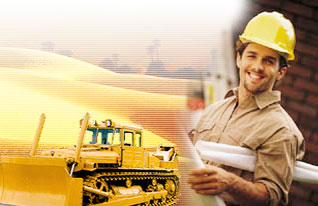



GENERAL INSTRUCTION
EMPLOYEES RESPOSIBILITY
Electricity: - All electrical equipment must;
Extension cables, plugs and sockets must be in perfect condition. Scindex cable is forbidden. Ensure open access to the manual circuit breaker on the outside of the trailer . To bury all cables at 30 cm. Minimum and forbid any vehicle to drive over. 1) Electrical conductors should be of sufficient size and current- Carrying capacity for the purposes they are intended. 2) All conductors should be either insulated, or properly safeguarded to prevent danger. 3) Every installation and circuit should be protected against over Current by automatic devices. 4) All electrical hand tools must be properly grounded. 5) Treat all wires as live wires. Do not touch hanging or broken Wires. Place a warning sign, and notify a supervisor or Electrician immediately.
· Electric Welding Welding mask gloves and leather apron are obligatory Ensure that nobody is watching at the operation.
· OXY ACETYLENE Gloves goggles and apron are obligatory. Be sure that the flame arrestors are in place and in good order. Change the pipes according their to state or the expire date written on it.
· DANGEROUS WELDINGS. Forbidden on any tank having contained petrol or fuel near any petrol container. On a diesel tank; be sure that the tank is empty fill it with a maximum of water, to complete with Co2 from an extinguisher, left its hose in the tank to renew Co2 during the operation, to weld gradually. On vehicles, be sure that there is no hydrocarbons or any flammable products nearby and prepare an extinguisher beside you.
· GAS STORAGE. In a well ventilating shaded location. N o smoking permitted in the area. Bottles standing up. Mark and separate the empty bottles. · WORKING UNDER A VEHICLE Goggles are imperative (gloves to be used when lifting heavy parts ) Jacked up vehicles must also be supported by axle. Stands and / or wooden blocks.
· OILS Separate storage in a no smoking area. Clearly indicate contents. Collect all waste oils for proper disposal; never throw used oils on the ground. Dispose containers under the drum tapes.
· INFLAMMABLE PRODUCTS.
· BATTERIES. Never smoke above batteries. Change batteries must be done in a delimited area with suitable signs and equipments. (Goggles, rubber gloves, eye -wash, fire extinguisher...) Pour always acid in water, never the opposite! ! ! ! · PERSONAL PROTECTIVE EQUIPMENT. Permanent staffs are required to wear full PPE. Drivers working in the area must wear overalls and standard footwear. They should not participate in dangerous tasks unless they have been trained and correctly equipped. Wear glasses for grinding, drilling, cutting and using the electric saw. In noisy environment use earplugs. In dust, for (bulldozers) drivers use dust masks.
· LIFTING
1. Be sure your footing is secure. 2. Keep your body erect. Always lift with your legs and not your back. 3. Use the correct lifting procedures for lightweight objects as you would for heavy weight. 4. Never pick up or put down an object while in a twisted position. 5. Never place yourself under a heavy object when it is being lifted.
Check the state of cables hooks and eyes. A cable with more than three broken stands must be replaced. Do not exceed maximum load. Nobody must stand or pass under the load. Never pull the load but push it. · EXTINGUISHERS Power and foam fire extinguishers are available at the workshop. Ensure that access to those is always available.
· CLAENING OF PARTS. Only with the cleaning product provided. Petrol is especially, particularly by spraying mode. Never clean hydraulic systems with diesel, use only recognized products.
· ACCIDENTS. A first aid kit is available in the workshop. Use the fire-blanket for bummed people. The doctor should be informed of even small cuts that will be recorded for analysis with the intention of reducing risks and defining preventative action. At least one person present in the workshop must have sufficient knowledge of first aid to attend to an injured person while awaiting the doctor .
· TOOLS a) The improper use of hand tools is the major cause of many Minor but painful injuries. b) Use proper tools, for the designed work. c) Replace all worn parts such as ratchets cogs, dies, handles and shields. d) All electric hand tools must be either grounded or double insulated. Three wire cords must be used with grounded tools. e) Some tools are designed with protective guards. If the Guard has been broken or removed, do not use the tool until the guard has been repaired or replaced. f) Keep machetes, knives, brush-hooks and axes sharp at all times and sheathed when not in use. · WINCHES AND CABLES 1) The winch cable should be run out and inspected regularly. 2) The winch cable should be maintained by keeping clean and oiling it with a light preservative. When re- spooling, avoid kinking the cable. 3) Always wear leather gloves when handling cables. 4) Never stand near, step over or go underneath a cable, it may suddenly go under tension, or it may break with a whipping action and fly through the air 5) Stand clear of objects being lifted or pulled. If the cable breaks, the objects may fall or roll back. · LADDERS AND SCAFFOLDS 1) If you have to climb, use a ladder. Make sure the Ladder is designed to support the load it's intended to bear. Face the ladder when going up or down. 2) A non- conducting ladder is recommended for us when working with electrical tools or any line electrical source. 3) All stepladder must be equipped with locking bars And must be locked in place before use. 4) When you are on a ladder, do not over- reach, the Ladder could slip or you could lose your balance. Get off the ladder and move it to the proper Position. 5) If you use scaffolds, make sure all planks and other Materials are free from knots & splits. 6) The flooring or base on which the scaffolding is placed must be stable, firm and even. 7) Ensure that the ladder or scaffolding cannot come Into contact with any overhead power lines or Radio transmission lines. · HAND TRUCK 1. Watch what you are doing when using hand trucks. Approach corners slowly and with Caution. 2. Do not over load the truck. Make sure you can Control the load and see over the top. 3. Secure the loads to prevent them from falling off. 4. Report needed repairs to your supervisor. 5. Use extra caution when pushing trucks on slippery or wet surfaces. 6. Wear shoes with good traction
|
|
||||
|---|---|---|---|---|
